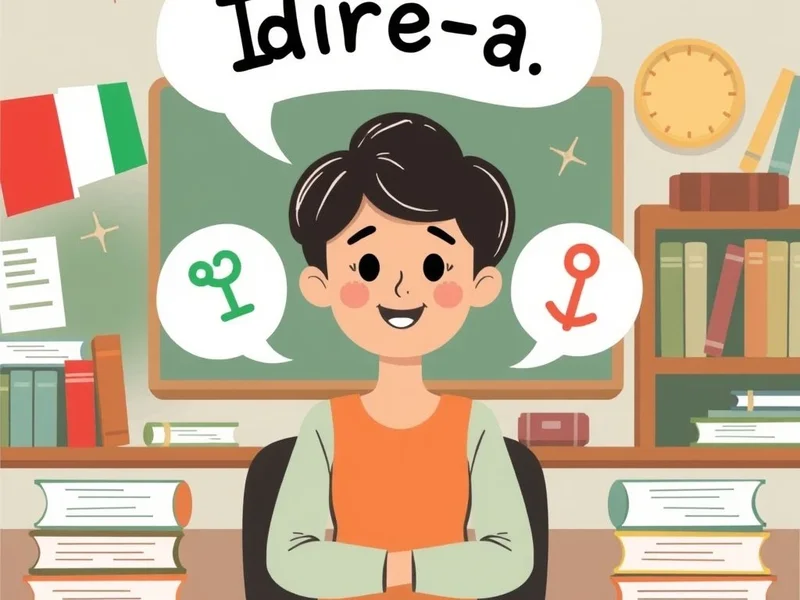How to Use "Dire a": Meaning, Usage, and Useful Phrases in Italian
Learning Italian often means dealing with expressions that seem simple but hide important nuances. One of these is the verb "dire" followed by the preposition "a". Many students ask themselves: "When should I use 'dire a' and when not?". This little "a" can make a big difference in natural speech and in Italian grammar when explained correctly. In this guide, we will explore in detail the meaning of "dire a", its structure, practical examples, and common mistakes to avoid, to help you communicate in Italian with more confidence.

Table of Contents
- What does "Dire a" mean?
- The Grammatical Structure: How Is It Used?
- Sentences and Examples with "Dire a"
- Crucial Differences: Common Mistakes to Avoid
- Similar or Related Expressions
What does "Dire a" mean?
- Literal Meaning: To verbally communicate something to someone.
- Example: "Ho bisogno di dire una cosa importante a Maria."
- Figurative Meaning: To assign a task, give an order, advice, or express a specific indication to a person or entity.
- Example: "Questo lavoro non mi dice niente (non mi interessa/non mi stimola)."
More: Dichiarare a Explained with Meaning and Practical Italian Examples
The Grammatical Structure: How Is It Used?
The most common structure for using dire a is: [Subject] + dire + a + [Indirect Noun/Pronoun]. The preposition "a" is essential because it introduces the indirect object, that is, the person or entity to whom the action of "dire" is directed.
- Basic formula: [Subject] + dire + a + [To whom?].
- Example: "Io dico a Marco la verità."
- With indirect pronouns: When we replace the noun with a pronoun, "a" merges with the indirect pronoun.
- Example: "Gli (a lui) dico la verità." or "Le (a lei) dico la verità." or "Vi (a voi) dico la verità."
It is important to note that the verb "dire" always takes an indirect object introduced by "a" when specifying the person being spoken to. You can say "dire qualcosa" (direct object) but you must say "dire a qualcuno" (indirect object).
More: Destinare a Explained with Meaning and Practical Examples
Sentences and Examples with "Dire a"
📍 Context: Family
Persona A: "Mamma, hai già detto a nonna che veniamo domenica?"
Persona B: "Sì, le ho detto ieri sera. Era contentissima!"
📍 Context: Work
Persona A: "Devo dire al capo che ho finito il progetto."
Persona B: "Perfetto, diglielo subito, è in ufficio."
📍 Context: Friends
Persona A: "Non so cosa dire a Luca per convincerlo."
Persona B: "Prova a dirgli la verità, forse apprezzerà la tua sincerità."
📍 Context: General Situation
Persona A: "Mi ha detto che non è possibile fare il rimborso."
Persona B: "Chi te l'ha detto? Non è giusto!"
More: Dedicarsi a: Meaning Usage and Essential Phrases in Italian
Crucial Differences: Common Mistakes to Avoid
The most common mistake with "dire a" is omitting the preposition "a" or confusing the direct object with the indirect object, especially when using pronouns.
Dire [something] vs. Dire a [someone]
- Common mistake: "Io dico lui la verità." (Grammatically incorrect)
- Correct: "Io dico la verità (direct object) a lui (indirect object)." or "Io gli dico la verità."
- The verb "dire" can have both a direct object (what is said) and an indirect object (to whom it is said). The mistake comes from literal translation from languages that do not use the preposition in this way.
Mi ha detto vs. Ha detto a me
- Both forms are correct, but they have different emphasis.
- Mi ha detto: more common and natural form, the indirect pronoun precedes the auxiliary verb.
- Example: "Mi ha detto che non sarebbe venuto."
- Ha detto a me: used to give emphasis, to specify "to me and not to others".
- Example: "L'ha detto a me, non a te!"
- According to the Accademia della Crusca, the use of unstressed pronouns (such as "mi", "ti", "gli", "le") is the standard form for the indirect object.
Similar or Related Expressions
| Similar Expression | Short Meaning | Example |
|---|---|---|
| Parlare a | To address someone verbally | "Ha parlato a lungo con il direttore." |
| Raccontare a | To tell a story or event to someone | "Mi ha raccontato una barzelletta divertente." |
| Spiegare a | To explain a concept to someone | "Puoi spiegarmi di nuovo questo passaggio?" |
Conclusion
Understanding and using dire a correctly is a fundamental step for anyone who wants to master Italian and communicate more authentically. Remember that the preposition "a" always indicates the person or entity receiving the action of saying. Pay attention to the indirect object and the use of pronouns to avoid the most common mistakes.
Now it’s your turn! Try writing a sentence using "dire a" in the comments below. What is the last thing you had to say to someone?